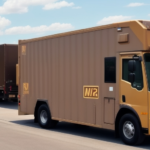Comparing Shipping Rates: UPS vs. FedEx
Shipping goods has become a critical aspect of businesses worldwide, making the choice of the right carrier increasingly important. UPS and FedEx are two of the largest shipping companies globally, both offering reliable and efficient shipping services. However, when comparing shipping rates between these industry giants, opinions can vary. This article provides a comprehensive analysis of the services offered by UPS and FedEx, compares their shipping rates, and incorporates up-to-date information to help you make an informed decision.
Company Background
A Brief History of UPS and FedEx
UPS, short for United Parcel Service, was founded in 1907 and began by delivering packages in Seattle, Washington. The company expanded across the United States as a messenger and local delivery service before launching its first air service in 1929. Today, UPS operates in over 220 countries and territories worldwide and employs more than 500,000 people.
FedEx, initially known as Federal Express, was founded in 1971 with a mission to revolutionize the shipping industry. Similar to UPS, FedEx started as an air cargo carrier before expanding into ground delivery services. Currently, FedEx ships to over 220 countries and employs over 400,000 people globally.
Business Models and Strategies
Despite their similarities, UPS and FedEx have adopted different business strategies. UPS has focused on building a vast ground network, boasting over 119,000 delivery vehicles and 5,000 operating facilities in the United States alone. In contrast, FedEx has invested heavily in its air fleet, operating more than 700 aircraft and serving 375 airports worldwide. This strategic difference has positioned UPS as the preferred choice for domestic ground shipping, while FedEx excels in the international air cargo market.
Shipping Services Offered
Both UPS and FedEx offer a wide range of shipping services tailored to various business needs. These include:
- Ground Shipping: Reliable and cost-effective for domestic shipments.
- Express Delivery: Overnight and two-day shipping options for urgent deliveries.
- International Shipping: Comprehensive global shipping solutions with customs clearance services.
- Specialized Services: Healthcare-specific shipping, temperature-controlled shipping for medical supplies, and industry-specific solutions for automotive, aerospace, and retail sectors.
- Additional Options: Signature confirmation, insurance, and customizable packaging services.
Both carriers also provide extensive networks of drop-off locations and online tracking services, enhancing convenience and transparency for businesses.
Shipping Rates and Pricing Structure
How Are Shipping Rates Calculated?
Shipping rates for both UPS and FedEx are influenced by several factors, including:
- Package Weight and Dimensions: Rates are calculated based on the actual and dimensional weight of the package.
- Destination: Domestic and international destinations affect the pricing differently.
- Shipping Speed: Expedited or overnight services are more expensive than standard ground shipping.
- Additional Services: Options like insurance, signature confirmation, and special handling may incur extra costs.
For example, a larger package with significant dimensions might incur higher costs compared to a smaller, heavier package due to dimensional weight pricing.
Comparison of International Shipping Options
International shipping with UPS and FedEx includes services like customs clearance, import/export handling, and global tracking. FedEx often offers competitive rates for international shipments, particularly for businesses shipping to multiple countries. UPS provides robust international services with extensive global reach, making it suitable for businesses with diverse international shipping needs.
Delivery Performance and Reliability
Delivery Times
Both UPS and FedEx are renowned for their reliable delivery times. However, the actual delivery speed depends on the selected service level:
- Overnight Services: Both carriers offer overnight delivery, with FedEx generally being slightly faster in some regions.
- Two-Day Shipping: Suitable for less urgent deliveries, providing a balance between speed and cost.
- Standard Ground Shipping: Cost-effective for non-urgent shipments, especially within the domestic market.
It's important to note that delivery times can be affected by factors such as package size, weight, and the time of day the package is dropped off. Both carriers offer tracking services to monitor the status and expected delivery time of shipments.
Tracking and Notifications
Tracking capabilities are robust with both UPS and FedEx. They provide real-time tracking updates and notifications via email or text messages. Additionally, both carriers offer options to redirect packages or hold them at nearby locations if the recipient is unavailable at the delivery address.
Customer Support
Customer support is a crucial factor in selecting a shipping carrier. Both UPS and FedEx offer comprehensive customer support through various channels:
- Phone Support: Available for immediate assistance.
- Email Support: For detailed inquiries and support requests.
- Chat Support: Real-time assistance through online chat platforms.
- Online Resources: FAQs, blogs, and how-to guides to address common issues and provide shipping information.
UPS is known for its personalized support, offering dedicated account managers for larger businesses and programs like UPS My Choice, which allows customers to customize delivery preferences. FedEx, on the other hand, is recognized for its swift response times and efficient issue resolution, along with the FedEx Delivery Manager program that enables real-time tracking and management of deliveries.
Environmental Impact
Both UPS and FedEx are committed to reducing their environmental footprint through various sustainable initiatives:
- UPS: UPS has pledged to achieve carbon neutrality by 2050 and is investing in alternative fuel vehicles and electric fleets. As of 2023, UPS operates over 10,000 electric vehicles and is incorporating renewable energy sources like solar and wind power in its facilities.
- FedEx: FedEx aims to reach carbon-neutral operations by 2040. The company is expanding its fleet of electric and alternative fuel vehicles and investing in energy-efficient infrastructure to support its sustainability goals.
According to the Climate Counts study, UPS has been recognized for setting more aggressive carbon reduction targets and implementing renewable energy solutions more extensively than FedEx. Both companies continue to innovate and invest in eco-friendly technologies to minimize their environmental impact.
Choosing the Right Carrier for Your Business Needs
Selecting the appropriate shipping carrier hinges on several factors specific to your business needs:
- Type of Goods: Consider the nature, size, and weight of the items you are shipping.
- Destination: Evaluate whether your primary shipping destinations are domestic or international.
- Delivery Speed: Determine the urgency of your shipments and choose a carrier that aligns with your delivery requirements.
- Budget: Analyze your shipping budget and explore cost-effective shipping options without compromising on reliability.
Tips for Reducing Shipping Costs
Here are some strategies to minimize shipping expenses with UPS and FedEx:
- Consolidate Shipments: Combine multiple packages into a single shipment to take advantage of bulk shipping rates.
- Use Flat-Rate Boxes: Both carriers offer flat-rate shipping options, which can be cost-effective for heavier items.
- Negotiate Rates: Businesses shipping high volumes can negotiate better rates with carriers based on their shipping volume.
- Leverage Contract Rates: Establish contract rates with UPS or FedEx to secure discounted pricing.
- Take Advantage of Seasonal Discounts: Carriers often offer promotions and discounts during peak shipping seasons.
Case Study: Comparing Shipping Costs for Different Products
Consider a business that ships a variety of products such as books, clothing, and electronics. The shipping cost will vary based on each item's weight, size, destination, and chosen shipping service. For instance, shipping lightweight books domestically may be more cost-effective with UPS Ground, while international electronics shipments might benefit from FedEx's competitive international rates. By analyzing the specific shipping requirements for each product category, the business can determine the most cost-effective carrier for each type of shipment.
International Shipping Options
When shipping internationally, both UPS and FedEx offer comprehensive services that include customs clearance, import/export handling, and global tracking. These services ensure that packages navigate international borders smoothly and reach their destinations efficiently. It's essential to understand the customs regulations and duties of the destination country to avoid delays and additional costs. Both carriers provide tools and resources to help businesses manage international shipments effectively.
Conclusion: Who Wins the Battle of UPS vs. FedEx?
Comparing UPS and FedEx reveals that both carriers offer efficient and reliable shipping services with competitive rates. The choice between the two ultimately depends on your specific business needs, including the type of goods you ship, your target destinations, delivery speed requirements, and budget constraints. By carefully evaluating the services, pricing structures, and additional features each carrier provides, you can select the best shipping partner to enhance your business operations, reduce costs, and improve shipping efficiency.






















